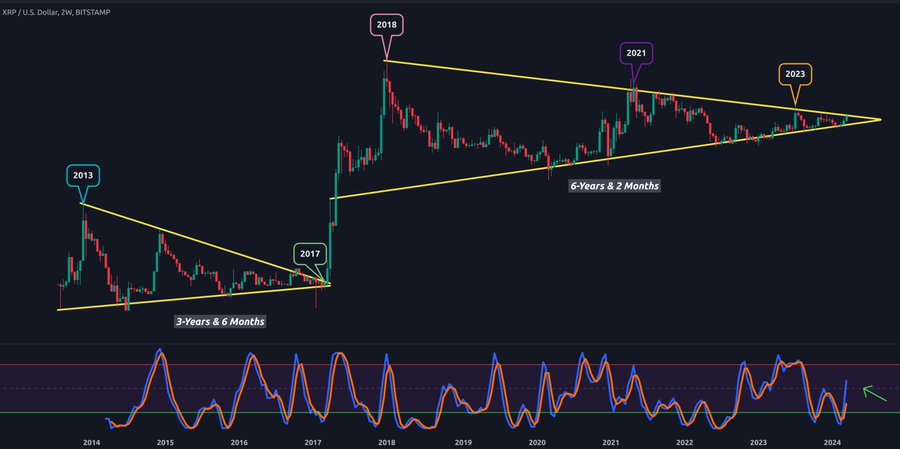- XRP is showing consolidation in a symmetrical triangle, anticipating a potential upside breakout similar to 2017.
- Currently, XRP is approaching a critical point within the symmetrical triangle, indicating potential for significant upside.
Recent technical analysis by Steve Courtney, an experienced trader, sheds light on the future upside potential of XRP, Ripple’s cryptocurrency. After a remarkable correction following its peak in March, which coincided with a general market decline, the Stochastic RSI technical indicator suggests a promising future for XRP, reminiscent of the pattern that preceded its spectacular rise in 2017.
#XRP's Symmetrical Triangle pattern from 2013-2017 resulted in a 58431% increase. 🚀💰
Will the current 6-year pattern follow suit? 🤔
The #StochRSI shows promising momentum. 🏹
Don't miss out, give us a Like/Retweet for all the latest updates! #CryptoPower 💪 pic.twitter.com/CIo4zQdw3s
— Steve Courtney ~ Crypto Crew University (@CryptoCrewU) March 17, 2024
Courtney highlights XRP’s current formation within a symmetrical triangle, a pattern that has historically indicated a consolidation phase before a significant breakout.

Such a formation suggests that, after years of consolidation, XRP could be setting up for a major upside move, similar to the one experienced when it surpassed a 58.431% rise after its previous symmetrical triangle.
XRP is currently consolidating inside another symmetrical triangle, according to Courtney, and appears to be approaching the breakout point. Despite previous failed attempts to overcome this pattern, Stochastic RSI signals indicate that XRP may be nearing the conclusion of its corrective phase, opening the door to a significant rally.
This analysis delivers a hopeful outlook for Ripple and XRP, hinting that, despite recent volatilities and challenges, the potential exists for another impressive bullish phase, similar to the one experienced in 2017. This scenario portends a positive impact on XRP’s valuation and could strengthen its presence in the crypto arena.



